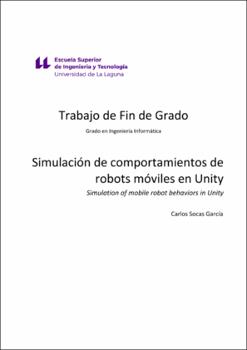Simulación de comportamientos de robots móviles en Unity.
Autor
Socas García, CarlosFecha
2022Resumen
Unity es un motor de desarrollo de videojuegos (game engine) el cual tiene una serie de rutinas
de programación que permiten el diseño, creación y funcionamiento de un entorno interactivo. Es
un software que centraliza todo lo necesario para poder desarrollar videojuegos. En este caso, se
utilizará para generar nuestra simulación. Por otro lado, ROS es un framework para el desarrollo
de robots que provee la funcionalidad de un sistema operativo en un clúster heterogéneo.
La idea principal de este proyecto es plantear una simulación donde sea posible analizar el
comportamiento de un robot móvil, en este caso una silla con tracción diferencial, mientras se
mueve por determinados espacios. La finalidad es generar mediante ecuaciones odométricas a
partir de las velocidades angulares de las ruedas la trayectoria estimada, y compararla con el
recorrido que realmente realiza el robot en la simulación. Esto permitirá obtener un ejemplo visual
de situaciones que se pueden dar en entornos reales cuando la silla desliza o derrapa, lo que
conlleva a diferencias en la trayectoria estimada por las ruedas respecto a la de referencia. Unity is a game development engine (game engine) which has a series of programming routines
that allow the design, creation, and operation of an interactive environment. It is a software that
centralizes everything necessary to develop video games. In this case, it will be used to generate
our simulation. On the other hand, ROS is a framework for the development of robots that provides
the functionality of an operating system in a heterogeneous cluster.
The main idea of this project is to propose a simulation where it is possible to analyze the behavior
of a mobile robot, in this case a chair with differential traction, while it moves through certain
spaces. The purpose is to generate the estimated trajectory using odometric equations from the
angular wheel velocities and, compare it with the route carried out by the robot in the simulation.
This will allow to obtain a visual example of situations that can occur in real environments when
the chair slides or skids, which leads to differences in the trajectory estimated by the wheels with
respect to the reference one.





